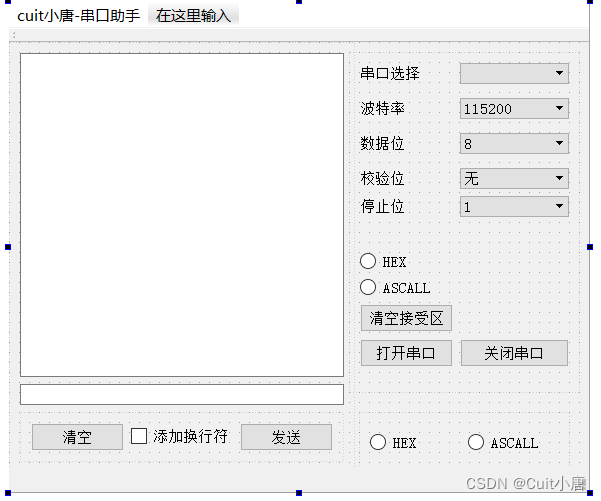Qt简单串口助手
自己对嵌入式和物联网方向比较感兴趣,参加了一个小比赛使用ht32单片机做一个简单的智能家居demo,就尝试写一个串口助手可以对板子进行调试。
demo结果:
将单片机测量到的温湿度打印到串口助手,串口发送1和0控制单片机LED1的亮灭。最后也是基本成功,但是无法识别中文和空格等字符,可以进一步进行优化处理。
实现步骤
1.需求分析
实现基本串口收发功能,需要串口搜索、基本参数的设置等。
2.UI界面构建
在qt的ui界面对串口助手进行设计,如下(其实应该使用widget,但是我创建项目时选择了mainwindow,无伤大雅 这里的HEX和ASCALL我用的是radioButton,没有使用group,但是只需要在初始化时进行一个默认选择即可。):
3. 代码实现
这里因为需要使用串口,所以需要在过程文件中加入串口需要的serialport
串口搜索即获取所有的可用串口:
//获取列表
QStringList MainWindow::getPortNameList()
{
QStringList serialPortName;
foreach(const QSerialPortInfo &info,QSerialPortInfo::availablePorts()) //查找所有的允许使用的串口
{
m_serialPortName << info.portName(); //将查找到的放入LIST
qDebug() <comboBox->addItems(m_serialPortName);//添加到显示界面
return serialPortName;
}
打开串口按钮功能:这里点击打开按钮,便会根据上面选择的参数进行相应的处理,对串口进行设置,同时里面绑定了两个槽函数,读取串口的信息以及显示的跟新。
void MainWindow::on_open_port_clicked()
{
m_serialPort = new QSerialPort();//实例化串口类一个对象
if(m_serialPort->isOpen())//如果串口已经打开了 先给他关闭了
{
m_serialPort->clear();
m_serialPort->close();
}
//设置串口名字 假设我们上面已经成功获取到了 并且使用第一个
m_serialPort->setPortName(ui->comboBox->currentText());
if(!m_serialPort->open(QIODevice::ReadWrite))//用ReadWrite 的模式尝试打开串口 读写
{
qDebug()<comboBox->currentText() << " 打开失败!";
return;
}
//打开成功
//设置波特率 只做了两个最常用的
if(ui->comboBox_2->currentText() == tr("9600"))//根据组合框内容对串口进行设置
m_serialPort->setBaudRate(QSerialPort::Baud9600,QSerialPort::AllDirections);//设置波特率和读写方向
else if(ui->comboBox_2->currentText() == tr("115200"))
m_serialPort->setBaudRate(QSerialPort::Baud115200,QSerialPort::AllDirections);//设置波特率和读写方向
//设置数据位
if(ui->comboBox_3->currentText() == tr("8"))
m_serialPort->setDataBits(QSerialPort::Data8); //数据位为8位
else if(ui->comboBox_3->currentText() == tr("7"))
m_serialPort->setDataBits(QSerialPort::Data7); //数据位为8位
//设置奇偶校验
if(ui->comboBox_4->currentText() == tr("无"))
m_serialPort->setParity(QSerialPort::NoParity); //无校验位
else if(ui->comboBox_5->currentText() == tr("奇校验"))
m_serialPort->setParity(QSerialPort::OddParity); //奇校验位
else if(ui->comboBox_5->currentText() == tr("偶校验"))
m_serialPort->setParity(QSerialPort::EvenParity); //偶校验位
//设置停止位
if(ui->comboBox_5->currentText() == tr("1"))
m_serialPort->setStopBits(QSerialPort::OneStop); //一位停止位
else if(ui->comboBox_5->currentText() == tr("2"))
m_serialPort->setStopBits(QSerialPort::TwoStop); //两位停止位
m_serialPort->setFlowControl(QSerialPort::NoFlowControl);//无流控制
//连接信号槽 当下位机发送数据QSerialPortInfo 会发送个 readyRead 信号,我们定义个槽readMycom()
connect(m_serialPort,SIGNAL(readyRead()),this,SLOT(readMycom()));
//值改变
connect(ui->receiveText,SIGNAL(textChanged()),this,SLOT(autoScroll()));
ui->open_port->setEnabled(false); //打开串口后“打开串口”按钮不可用
ui->close_port->setEnabled(true); //打开串口后“关闭串口”按钮可用
ui->btn_send->setEnabled(true); //打开串口后“发送数据”按钮可用
ui->btn_clc1->setEnabled(true);//清空按钮
ui->btn_clc2->setEnabled(true);//清空按钮
ui->comboBox_2->setEnabled(false); //设置combox不可用
ui->comboBox_3->setEnabled(false);
ui->comboBox_4->setEnabled(false);
ui->comboBox_5->setEnabled(false);
ui->comboBox->setEnabled(false);
} 界面刷新
//自动刷新界面显示信息,向下面滚动
void MainWindow::autoScroll()
{
QTextCursor cursor = ui->receiveText->textCursor();
cursor.movePosition(QTextCursor::End);
ui->receiveText->setTextCursor(cursor);
}读取串口:这里的两种模式是网上比较通用的两种,于是在这里进行了判断,这段函数是后面进行完善的。
void MainWindow::readMycom(void) //读串口函数
{
QBAtemp = m_serialPort->readAll();
Qstrtemp.clear();
qDebug() <<"read mycom";
for(int j = 0 ; j < QBAtemp.length();j++)
Qstrtemp += QBAtemp[j];
if(recvmodel == ASCII)//ASCII码 其实是string类型
{
ui->receiveText->moveCursor(QTextCursor::End);
ui->receiveText->insertPlainText(Qstrtemp);
//ui->textBrowser->append(Qstrtemp);
qDebug() << "ASCII :" << Qstrtemp;
}
else
{
ui->receiveText->append(StringtoHex(Qstrtemp));
qDebug() << "HEX :" << StringtoHex(QString(Qstrtemp));
}
qDebug() << Qstrtemp << ":" << Qstrtemp.length();
}到这一步其实已经可以接收单片机传递过来的信息了,默认的string类型可以直接显示
关闭串口
void MainWindow::on_close_port_clicked()
{
m_serialPort->close();
ui->open_port->setEnabled(true); //打开串口后“打开串口”按钮不可用
ui->close_port->setEnabled(false); //打开串口后“关闭串口”按钮不可用
ui->btn_send->setEnabled(false); //打开串口后“发送数据”按钮不可用
ui->btn_clc1->setEnabled(false);
ui->comboBox_2->setEnabled(true); //设置combox可用
ui->comboBox_3->setEnabled(true);
ui->comboBox_4->setEnabled(true);
ui->comboBox_5->setEnabled(true);
ui->comboBox->setEnabled(true);
}ASCALL 转 HEX :勾选之后再进行处理即可
QString MainWindow::StringtoHex(QString buf)
{
QString sret;
QByteArray Qba = buf.toLatin1();
QDataStream out(&Qba,QIODevice::ReadWrite);
while(!out.atEnd())
{
qint8 outchar = 0;
out >> outchar;
QString str = QString("%1").arg(outchar & 0xFF,2,16,QLatin1Char('0')).toUpper() + QString(" ");
sret += str;
}
return sret;
}HEX 转 ASCALL 勾选之后再进行处理即可
QString MainWindow::HextoString(QString buf)
{
QByteArray ret;
QString Qstr;
bool ok;
buf = buf.trimmed();
buf = buf.simplified();
QStringList sl = buf.split(" ");
foreach(QString s,sl)
{
if(!s.isEmpty())
{
char c = s.toInt(&ok,16) & 0xFF;
if(ok){
ret.append(c);
}
else
{
qDebug() << "非法字符";
}
}
}
for(int i = 0 ; i < ret.length();i++)
Qstr += ret[i];
return Qstr;
}发送功能:调用write函数即可,这里判断是否选择换行
void MainWindow::on_btn_send_clicked()
{
if(sendmodel == ASCII)
{
if(ui->checkBox->checkState() == Qt::Checked)
{
Qstrtemp = ui->sendText->text() + "\r\n";
}
else
Qstrtemp = ui->sendText->text();
m_serialPort->write(Qstrtemp.toLatin1(),Qstrtemp.length());
}
else
{
if(ui->checkBox->checkState() == Qt::Checked)
{
Qstrtemp = ui->sendText->text() + "0D 0A";
}
else
Qstrtemp = ui->sendText->text();
qDebug() <<"666" +Qstrtemp;
qDebug() <<"666" +HextoString(Qstrtemp);
m_serialPort->write(HextoString(Qstrtemp).toLatin1(),HextoString(Qstrtemp).length());
}
}清除功能:简单,直接把界面清空即可
至此,串口助手设计结束

